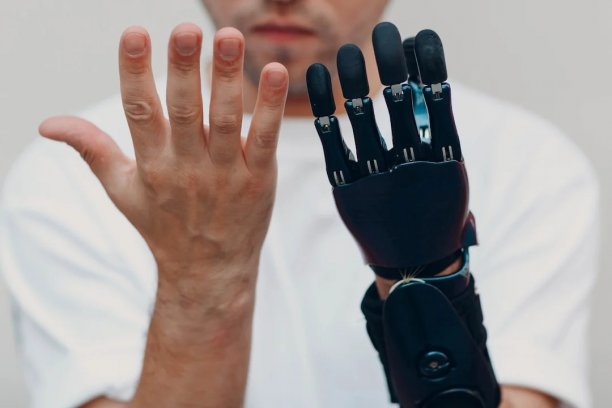
Fashion for Good launches new Good Shop theme
Fluidic actuation based on pressurised air or liquid is gaining traction in soft robotics and textile-based wearables.

3rd April 2025
Innovation in Textiles
|
Houston, TX, USA
Haptic devices which enable communication through touch have evolved significantly since their introduction in the 1960s.
Initially, they relied on rigid, grounded mechanisms acting as user interfaces, generating force-based feedback from virtual environments. With advancements in sensing and actuation technology, however, haptic devices have become increasingly wearable.
Today’s innovations focus on cutaneous feedback – stimulating the skin’s receptors to provide realistic touch sensations – rather than kinesthetic feedback, which mimics force exerted on the musculoskeletal system.
Recently, a team of experts including Rice University’s Marcia O’Malley and Daniel Preston have published an in-depth review in Nature Reviews Bioengineering analyzing the current state of wearable multisensory haptic technology.
Shift to multisensory
“Wearable haptic devices are now integrated into consumer products such as smartwatches and gaming accessories, and they are serving more complex roles in health care, robotics and immersive media,” explains O’Malley, professor and chair of mechanical engineering at Rice. “A new shift towards multisensory haptic feedback – which means delivering more than one type of touch stimulus simultaneously – is enhancing user experience, but it presents new engineering and perceptual challenges. As this technology continues to evolve, we will see it move to a richer, multisensory experience – one that bridges the gap between digital interaction and human touch.”
Designing effective, wearable multisensory haptic devices requires a deep understanding of human touch perception, and the research team has identified several key challenges in the field today. One of the most significant hurdles is the variability in skin contact mechanics because differences in skin elasticity, receptor distribution and external factors like humidity can alter how haptic stimuli are perceived. Another issue is tactile masking, where multiple haptic sensations such as vibration and skin stretch can interfere with one another, reducing perceptual clarity.
“Every person’s skin responds differently to stimuli due to variations in elasticity, moisture and even body hair,” says Daniel Preston, who is assistant professor of mechanical engineering at Rice. “This variability makes designing universally effective devices incredibly complex.”
Design for fit
In addition, wearability and comfort continue to be major considerations in every product. Haptic devices must be designed to fit different body locations without causing discomfort, restricting movement or disrupting daily activities. Factors such as weight, size and attachment methods all play a crucial role in ensuring long-term usability.
“True immersion in haptic technology depends not just on what users feel but on how naturally and comfortably they experience it,” Preston says.
In addition to highlighting challenges, the authors identified several emerging actuation methods that could redefine wearable haptic technology.
Electromechanical actuation, commonly used in vibrational feedback systems, remains the most widely adopted method due to its reliability and affordability. However, it often struggles to provide a diverse range of haptic cues. Polymeric actuation, which relies on smart polymers that change shape or texture when exposed to stimuli, offers a lightweight and flexible alternative for delivering haptic feedback. Fluidic actuation, based on pressurised air or liquid to generate dynamic tactile sensations, is gaining traction in soft robotics and textile-based haptic wearables, offering new possibilities for comfort and adaptability. Additionally, thermal actuation is emerging as a way to enhance immersion in virtual environments or simulate real-world interactions through warming or cooling sensations.
“We expect these technologies to significantly expand the scope of haptic feedback, particularly in fields such as medical rehabilitation, prosthetic development and human-machine interaction,” says O’Malley. “Although promising, further refinement is needed to improve response time, durability and energy efficiency.”
Augmented reality
The review also offers insight into how wearable haptic technology is poised to unlock new possibilities in human interaction with digital and physical environments. In virtual and augmented reality, multisensory haptics enhance immersion by allowing users to feel digital objects, improving experiences in gaming, training simulations and education. In health care and rehabilitation, they can assist in motor skill training, post-stroke rehabilitation and prosthetic limb feedback, enabling patients to interact more effectively with their surroundings.
Assistive technology and communication applications leverage tactile interfaces to help individuals with vision or hearing impairments by translating auditory or visual information into touch-based signals. Navigation and guidance systems benefit from haptic wearables by providing intuitive directional cues, aiding visually impaired individuals and improving hands-free navigation in fields such as military and aviation. Additionally, teleoperation and robotics stand to gain significantly as remote-controlled robotic systems with haptic feedback allow users to ‘feel’ objects from a distance, improving precision in delicate tasks like robotic surgery.
Despite significant progress, the authors emphasised the need for further exploration. Understanding how the brain processes simultaneous haptic cues will be crucial in refining future devices and ensuring widespread adoption will require a balance between technological sophistication, user comfort and practical usability.
“The ultimate goal is to create haptic devices that feel as natural as real-world touch,” O’Malley concludes.
Reported by Rice media relations specialist Alexandra Becker

Business intelligence for the fibre, textiles and apparel industries: technologies, innovations, markets, investments, trade policy, sourcing, strategy...
Find out more